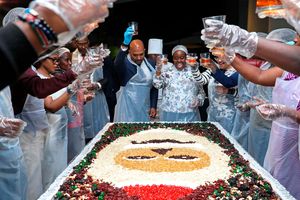
Chapati is a staple meal in many homes in Kenya during Christmas.
Chapati, the venerable chapati. Correction: The once-venerable chapati. Once rare like the spotted big cat whose skin it resembles, appearing only on very special occasions like Christmas, nowadays you will find it being tossed and turned at every corner of the republic; in every last dinghy food kiosk.
Chapati is perhaps the perfect metaphor of how Christmas has evolved in most parts of Kenya over the years. Once an eagerly awaited feast with many memorable activities, it is fast becoming just another day for some Kenyans.
“I think as time goes by, Christmas will lose meaning. Most people are not aware that Christmas is taking place on Monday (today). To them, it will be just like a normal day,” Nairobi-based businessman Paul Ogero Manoti told “Nation” last week.
Why is Christmas evolving into a bland observance? Some blame the social media. Others think it has to do with the economic times. There are those who point an accusatory finger at an increasingly secularised society.
However, the more one researches about Christmas, the more one realises that it has always been an evolving celebration which has been banned in some countries like England and the US at some point in history but somehow lived on.

Beehive of activities at Machakos Country Bus Station on December 24, 2023, this is as several town service vehicles are plying long distances as they try to make a fortune and meet demand as masses travel upcountry for the festivities.
Secular elements
Think chapati again. At its most basic, it emerges out of water, wheat flour, sugar, salt, oil and heat, right? Christmas is hardly a chapati-like concept, if you were to liken it to a dish. It is more like a pizza: it starts with some wheat flour base and then some layers from far and wide are lumped on top. One topping from one corner of the globe, another spice from the opposite corner, another layer from goodness-knows-where and in the end you have something to serve; something surprisingly harmonious.
Historians concur that Christmas as we know it is a mixture of both Christian and secular practices, marinated in the sauce of humans’ desire to celebrate and heated by the fire of human migrations in a large sufuria called globalisation.
The Christmas tree, for instance, originated from Germany. Santa Claus in all his potbellied wizened self traces roots to a Greek bishop. Gifting was an American topping. Christmas being held in December comes from the Roman winter festival called Saturnalia.
Meanwhile, in mediaeval England, Christmas used to be a 12-day festival. That is before it was banned, contributing to a civil war, according to the National Geographic. Some would wish that the 12-day tradition caught on.
Wonder why this season sees many people migrate to the countryside to congregate with family? This tradition of having Christmas as a family celebration was cemented in the US in the late 1800s and spread across the world.
By the time the Christmas phenomenon reached Kenya, thanks to missionaries and imperialists, there was a version of it that was imprinted in the minds of Kenyans. This was the version that required the buying of new clothes and shoes ahead of the big day.
Houses in the countryside received a fresh round of smearing. Families congregated to feast; feasts that translated to various animals losing their necks and heading to the cooking pot not long afterwards. Choice meals and drinks were consumed. This is rice, mandazi, pilau, samosas, nyama choma, cake, soda, and not forgetting chapati. The venerable chapati. Booze was consumed in copious amounts. Love was sought and love was made.
Back in the day, this was perhaps the only day of the year when families shot photos together, all made possible by the celebrated village photographer whose word (cue “the film got burnt and all photos got lost”) was law.
However, as subsequent generations arose, the day has been evolving and the red it came with is figuratively getting lighter. It is in the region of pink, if the current trends are anything to go by.
“The excitement has gone down unlike back in the days where ululations could rent the air the whole month,” says Mr Mose Mitenti, a Kisii-based certified public accountant.
“With the skyrocketing cost of living, parents don’t spend much on new clothes for their children, unlike in our days. Most are spending on school uniforms for their children in preparation for school,” adds Mr Mitenti, a man in his thirties who has operated a boutique in Kisii town.

Travelers at the Machakos Country Bus Nairobi County await to board Matatu on Sunday December 23 in a last rush ahead of Christmas Day.
Commercialisation
He goes on: “The excitement on food has also gone down as eating chapati or mandazi is a ‘kawaida’ (usual) thing on normal days, thanks to the change of perception on our daily menu.”
Anglican cleric Sammy Wainaina, in a 2022 sermon titled the “Hope of Christmas”, spoke to another element of latter-day Christmas: Commercialisation.
“This story of human liberation has been commercialised and it is no longer about Him. We celebrate his birthday with a cake but Christ is not welcomed to His own party. Christmas is meant to bring ‘happiness’ but it brings such brokenness, pain and artificial joy,” said Rev Wainaina, then the provost of the All Saints Cathedral in Nairobi.
No sooner does December hit than businesses start using the “this Christmas” tagline on advertising. All manner of offers are splashed to tap into the festive season shopping.
With the tough economic times Kenyans are facing, the shopping frenzy will, however, register less on the traders’ books. A recently released study by WorldRemit showed that Kenyan families will have to spend at least 24 per cent more on festivities this year compared with 2022.
Mr Manoti says one area where there will be less spending is transport.
“For example, for me to travel from here (Nairobi) to Kisii, one way it’s Sh2,000. To and fro, that’s Sh4,000. And I haven’t taken lunch; I haven’t bought shopping for my parents. So, I prefer sending money to travelling upcountry to meet my folks,” he says.
The businessman also thinks technology has contributed to the fading lustre of Christmas.
“We have family WhatsApp groups and also we have created this WhatsApp group where we chat every day, which has made it seem like we are together but in the real sense we are not. And also, the video calls that we do to family members have made it lose that value of us travelling to ‘ushago’ (countryside) to go and meet our parents, our cousins, our uncles and all,” he argues.
Religious origins
Like Rev Wainaina, many religious puritans have, times without number, been calling upon the public to realign Christmas with its religious origins.
Preaching about Christmas in a December 10 sermon, Rev Evelyne Wairimu of Christ is the Answer Ministries posed: “Have you received Jesus, this Jesus whom we celebrate the world over? it’s not enough just to say it’s Christmas. What has Christmas done for you? The saviour of the world came; have you received him? Have you acted on the message?”
Amid the all-too-familiar sizzle of the chapati on the pan, the aroma of meat being prepared in every which way, the stupefying fragrance of a lover dressing up to show up for a Christmas date, the sonorous Christmas carols blasting from every corner, the spectacle of an impromptu beachwear pageantry by people making merry at water bodies, the cackles of children playing at amusement parks and the gassy sound of bottles being opened to bring forth party liquids, a Christmas evolution goes on. Want to take a guess on what will constitute a Kenyan Christmas in 2100?









